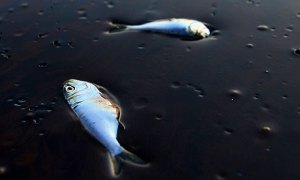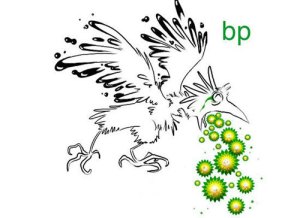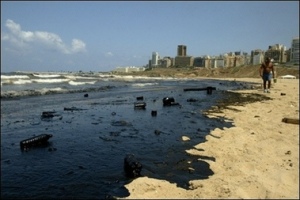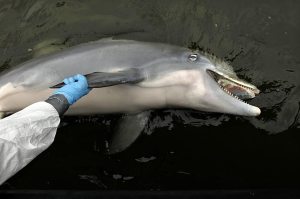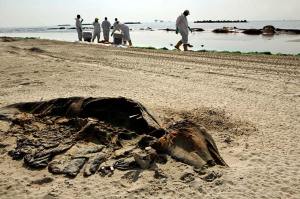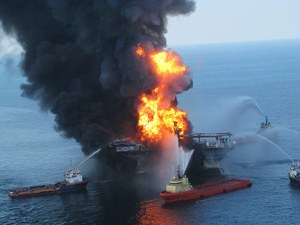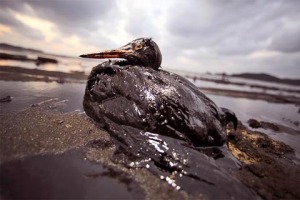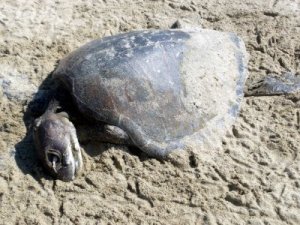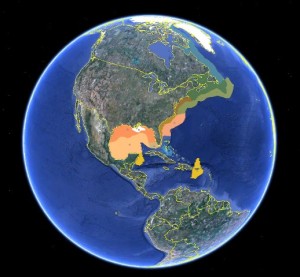It is the worst oil spill in the history of mankind. It will be polluted for several decades, and possibly well into the 22nd century, perhaps longer. The site of the Exxon oil spill, is still polluted to this day.
Killing thousands of fish, sea turtles, dolphins, Portuguese man o’war, birds, and destroying the seafood industry.
Biologist have found ‘dead zones’ around the BP oil spill in the Gulf of Mexico.
Methane at 100,000 times normal levels have created oxygen-depleted areas devoid of life near BP’s Deepwater Horizon spill.
Scientist have detected what they describe as “Astonishingly high” levels of methane, or natural gas, bubbling from the well site, this sets off a chain reaction that sucks the oxygen out of the water. Methane concentrations are 100,000 times normal levels, in some cases.
The animals are going away from the oil spill, where there is oxygen depletion.
Scientist studying the effects of the spill at that depth, said the ruptured well was producing up to 50% as much methane as other gases as oil.
-
Scientist suggest the high volume of methane coming out of the well could upset the ocean food chain. Such high concentrations would trigger the growth of microbes, which break up the methane, but also gobble up the oxygen needed by marine life to survive, driving ou other living things.
-
The ocean water there can go completely anoxic (extremely low oxygen) which is a very serious situation for any oxygen-requiring organism.
-
Although they haven’t seen zero-oxygen water, there is certainly enough gas in the water to draw the oxygen down to zero.
-
Which in effect, will wreak havoc with those communities that require oxygen.
Wiping out plankton and other organisms at the bottom of the food chain.
-
So far, scientist have detected 30% depletion of oxygen in some locations.
-
Things are changing, and what impacts there are on the food web are not going to be clear untill scientist to out and measure that.
-
-
-
-
Chemical Dispersants
-
BP’s decision to break down the oil and keep it from reaching the shore by applying massive quantities of toxic chemical dispersants.
-
Chemical soup
BP has poured an unprecedented volume of dispersant – over 800,000 gallons – into the Gulf of Mexico. This is the first time dispersants have been applied directly at the source of an undersea leak, as opposed to being sprayed onto an oil slick on the water’s surface.
-
The dispersant “COREXIT(R)EC9527A, which carries warnings that repeated or excessive exposure may cause injruy to red blood cells, the kidney or liver.
-
All dispersants have ethylenes in them. And the problem with these toxicants is, for the people who are working with them all the time, it can actually de-fat the top layer of the skin, making it dry, and then fissured, and then chapped, and then they can develop a sort of chronic dermatitis.
-
They can effect the peripheral nerves, causing persons to lose sensation in their fingertips.
That’s because the fat insulating the long nerves in the body get dissolved.
That’s what these things do – they’re solvents.
These chemical dispersants are creating…
-
-
-
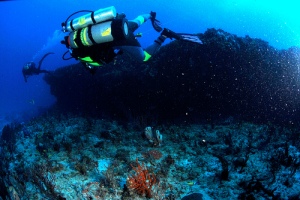
Large underwater oil plume.
-
Underwater Oil Plumes
-
Scientist have discovered oil plumes in the deep waters of the Gulf of Mexico, including one as large as 10 miles (16 km) long, 3 miles (4.8 km). Other researchers have found that the oil may occupy multiple layers. Marine scientist discovered a second oil plume, stretching 22 miles (35 km) from the leaking wellhead toward Mobile Bay, Alabama. The oil has dissolved and is no longer visible. Undersea plumes are the result of the use of wellhead chemical dispersants.
Samples from all undersea plumes were in very low concentrations, less than 0.5 parts per million.
-
Vast plumes of oil from the spill are spreading underwater, oil is massing and spreading in the gulf water column.
Then there is the unknown effects of the chemical dispersants used to break up the oil slick.
There are gases being released into the atmosphere, that are coming out with the oil.
Methane. The high concentrations of gases, 200,000 cause microbes which suck all the oxygen out of the water. This is creating “dead zones”, in which undersea life can not survive without oxygen. I can only guess at how this may effect and impact global warming.
As you know, a bird has a natural repellent in its feathers that keeps the water out. That’s a little area — a little cushion — that keeps it cool. Well, this oil here gets on those feathers, and they lose that little insulation. And then, when you have this oil at 100+ degrees, the bird experts say, it begins to literally cook the birds.
Burning Oil & Air Pollution Risk
The plans to burn off oil and gas will increase air pollution risk. When the winds come from the south, it will blow the emissions toward shore and decrease air quality.
The burnings place persons at risk of adverse health effects. A eky health concern is benzene a known cancer-causing agent found in oil and refined gasoline.
Clearly three months is a chronic exposure for people onshore and the workers doing the response activity. Other chemical concerns are semi-volatile chemicals that BP cleanup workers are being exposed to such as polynuclear aromatics.
Some workers were treated for heat exhaustion and some were not getting protective gear.
The Environmental Effect of Burning Oil
Workers are burning the oil off the surface of thw water in the Gulf of Mexico. But what about the effect that thick clouds of black smoke have on the environment.
35,000 to 60,000 barrels of oil a day are pouring into the Gulf of Mexico, a total of around 3.5 million barrels so far.
To quickly prevent the oil from reaching land, thousands of barrels of oil are being burned, creating thick black clouds of smoke.
The plumes of smoke are raising new questions about the health, safety and the oil’s effect on the environment.
There are some benefits of burning oil: It’s quick, it gets the oil out of the way from wildlife and keeps it away from the coast. But getting oil out of the water and putting it in the air is not fixing the problem, it’s only changing it.
-
The incineration of these hugh amounts of oil, combined with the black smoke, is creating air pollution hazards in the form of toxic gases, such as sulfar dioxide and carbon monoxide.
-
Like the first responders and volunteers who helped in the cleanup after 9-11, it is the 2,000 workers on the site at the disaster who are most vulnerable to the pollution, suffering symptoms of coughing, and irritation of the eyes and lungs.
-
-
-
-
Duck covered in oil.
-
Effects on Wildlife
-
With more than 400 fish and wildlife species relying on the Gulf Coast for food, cover, and breeding areas, the BP Oil Spill threatens the survival of marine and terrestrail species not only now, but in the long term as well.
-
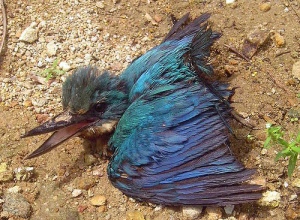
Young Bird
-
Similar to the Exxon-Valdez oil spill, populations of fish, shellfish, marine mammals, birds and other wildlife that depend on coastal habitat may not recover, even decades later.
-
How Oil Impacts Wildlife
The contamination of fragile habitat waters by the BP oil spill has cause death by the thousands of wildlife.
* Dead Mammals: 52
* Dead Birds: 1,317
* Dead Sea Turtles: 441
-
-
-
-
-
-
Brown Pelican covered in oil.
-
Impacts on Birds
-
Egrets, herons, ibises, roseate spoonbills, brown pelicans and Wilson’s plovers lose buoyancy and their ability to keep warm; suffer skin and eye lesions; and ulcers, pneumonia, liver damage, and other life-threatening conditions from ingesting oil when they try to feed or clean oil from their feathers.
-

Pelican sits dejectedly on the shoreline.
-
-
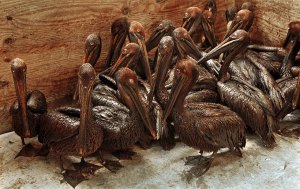
A group of oiled brown pelicans.
-
Many ground-nesting shorebirds, including plovers and terns, are at risk of losing their eggs and young.
-
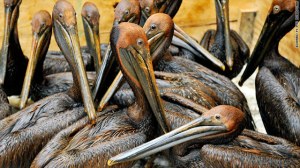
Oiled pelicans await treatment.
-
Millions of migratory birds use the Gulf Coast as a critical stopover point after the exhausting flight across the Gulf of Mexico and will face habitat and food shortages as oil washes ashore.
-
-
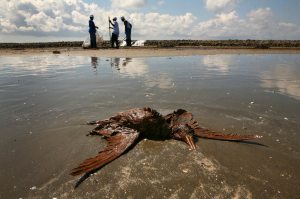
Dead oil-soaked bird.
-
-
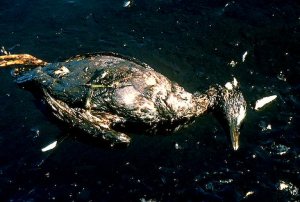
Dead-oil-bird.
-
-
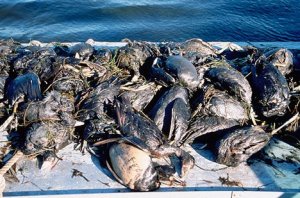
BP’s Dead Birds.
-
-
-
Impacts on Fish
-
* yellowfin tuna, blue tuna, blue crabs, sharks, oysters, shrimp and other species lose their ability to fight disease
and experience a build-up of contaminants in their bodies over time.
-
* Oil expusure is leathal to fish eggs and larvae that are not yet mobile and cannot escape the oil slick.
-
-
-
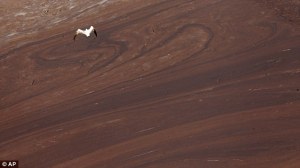
An Eagle flies over a vast brown area of the oil spill.
-
Impacts on Habitat
-
Ninety percent of all the marine species in the Gulf depend on coastal estuaries at some point in their lives, and most of these estuaries are in Louisiana. Louisiana’s estuarine habitat includes salt marshes and barrier islands that sit on the edge of Louisiana’s coast, and those will be hit first–and hardest–by the oil spill.
-
* Oil is harder to remove from the highly organic soils that occur in coastal wetlands and marches.
-
* Oil can kill or reduce growth of marsh grasses, which are a key source of food and cover for wildlife. This
vegetation loss will also lead to erosion and contribute to the coast’s already rapid rate of land loss.
-
-
-

Oil surrounds parts of Chandeleur Islands in Gulf.
-
Polluted Ecosystem = Polluted Economy
-
The Gulf Coast states rely heavily on commercial fisheries brought in a total $659 million in shellfish and finfish in 2008. Just over 3 million people took recreational fishing trips in the Gulf that year as well.
-
As oil spreads through the Gulf, fishing grounds are already undergoing temporary closures as state wildlife and fisheries officials test for contamination.
-
* The area affected by the spill is prime spawning ground for fish, shrimp, crabs, and is full of oyster beds.
-
* The Gulf Region accounts for about one-fifth of total U.S. commercial seafood production and nearly three-
quarters of the nation’s shrimp output.
-
* Louisiana produces 50 percent of the U.S. shrimp crop, 35 percent of the nation’s blue claw crabs, and 40 percent
of its oysters.
-
-
Other methods are being done to help remove the oil, such as the usage of dispersants and skimming. There is also a process known as bioremediation, which is the natural breakdown of oil which occurs, thanks to bacteria in the water which eats at the petroleum.
-
-
-
-
BP Oil Spill Relief Well Scenarios
As engineers bore deeper into the seafloor toward the source of the oil spewing into the Gulf of Mexico, BP PLC is growing more confident that the relief well it expects to complete in August will succeed where all previous efforts to contain or kill the gusher have failed.
-
-
-
-
BP Updates
-
-
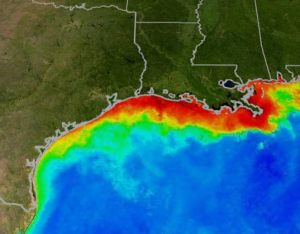
Gulf of Mexico Dead Zone
-
Oil Spill Spreads To Every State On Gulf Coast
-
Tar balls from the Gulf oil spill found on a Texas beach were confirmed Monday (July 5th, 2010), as the first evience that gushing crude from the Deepwater Horizon well has reached all the Gulf states.
-
The amound discovered is tiny in comparison to what has coated beaches so far in the hardest-hit parts of the Gulf coast in Louisiana, Mississippi, Alabama and the Florida Panhandle. It still provoked the quick dispatch of cleaning crews and a vow that BP will pay for the trouble.
-
“Any Texas shores impacted by the Deepwater spill will be cleaned up quickly and BP will be picking up the tab,” Texas Land Commissioner Jerry Patterson said in a news release.
-
About five gallons of tar balls were found Satarday on the Bolivar Peninsula, northeast of Galveston.
The largest tar balls found Saturday were the size of ping-pong balls, while the ones found Sunday were the size of nickels and dimes.
-
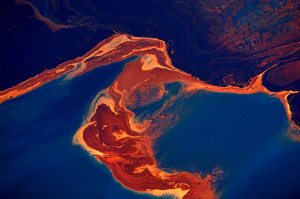
Oil slick in Gulf from a helicopter.
-
The spill is reaching deeper into Louisiana. Strings of oil were seen Monday in the Rigolets, one of two waterways that connect the Gulf with Lake Pontchartrain, the large lake north of New Orleans.
-
So far it’s scattered stuff showing up, mostly tar balls. It will pull out with the tide, and then show back up.
-
The oil is expected to clear the passes and move directly into the lake, taking a backdoor route to New Orleans.
-
Skimming operations across the Gulf have scooped up about 23.5 million gallons of the oil-fouled water so far, but officials say it’s impossible to know how much crude could have skimmed in good weather because of the fluctuating number of vessels and other variables.
-
The British company has now seen its cost from the spill reach $3.12 billion, a figure that desn’t include a $20 billion fund for damages the company created last month.
-
Today, the oil spill reached the last state on the Gulf Coast. The Associated Press reports that tar balls washed up on Texas beaches today, marking the first report of oil damage to the state of Texas. The oil spill has already fouled beaches and coastlines in Louisiana, Alabama, Mississippi, and Florida.
-
-
Scientist have spotted the first indications oil is entering the Gulf seafood chain – in crab larvae – and the effect on fisheries could last years, probably not a matter of months and affect many species.
-
Scientist have found droplets of oil in the larvae of blue crabs and fiddler crabs sampled from Louisiana to Pensacola, Florida. The news comes as blobs of oil and tar continue to wash ashore in Mississippi in patches, with crews in chartreuse vests out cleaning beaches all along the coast on Thursday, and as state and federal fisheries from Louisiana to Florida are closed by the BP oil disaster.
-
We may see this enter the food chain in a lot of ways – for plankton feeders, like menhaden, they are going to just actively take it in. Fish are going to feed on crab larvae. Scientist are seeing it on the fins of small, larval fish – their fins were encased in oil. That limits their mobility, so that makes them easy prey for other species. The oil’s going to get into the food chain in a lot of ways.
-
-
-
-
BP oil spill increases arsenic in ocean
-
The BP oil spill in the Gulf of Mexico is increasing the level of arsenic in the ocean, British scientists said Monday. Imperial College London researchers published a study which found oil stops the ocean’s natural filtering process of arsenic. The arsenic then gets “magnified” up the food chain.
-
-
-
-
Gulf Oil Spill Cost $3 Billion
BP’s cost for the disasterous Gulf of Mexico oil spill climbed nearly half a billion dollars in the past week, raising the oil giant’s tab to just over $3 billion for work on cleaning and capping the gusher and payouts to individuals and governments.
-
-
-
-
BP Buys Top Google Results for “Oil Spill”
-
BP has purchased sponsored links that appear at the top of Google and Yahoo’s search results for terms like “oil spill” in its attempts to improve its public image in the wake of its massive oil spill in the Gulf of Mexico.
-
It’s a great way for BP to manage their brand. With control over the search term – they can influence the opinions of people looking up the topic much easier. I realized they were doing this with Facebook Ads weeks ago, already.
-
-
-
-
BP Oil Spill Loan Rises to $9 Billion
LONDON—BP PLC’s standby loan has inched up to around $9 billion as more banks join the group of lenders supporting the company against possible claims related to the oil spill in the Gulf of Mexico.
Around eight or nine banks have agreed to lend around $1 billion each to BP on a bilateral basis. BP is calling on its relationship banks to provide liquidity and more are likely to join the group.
Among the banks likely to be lenders are Barclays PLC, BNP Paribas SA, Citigroup Inc., Banco Santander SA, HSBC Holdings PLC, Royal Bank of Canada, Royal Bank of Scotland Group PLC and Société Générale SA.
The standby loans provide the company with immediate access to liquidity to deal with the cost of the oil spill and meet its liabilities while BP considers longer-term funding options.
The loans have a one-year maturity with a one-year extension option.
-
-
-
-
Clean Up Crews Most Likely to Suffer Chronic Health Disorders
-
From the chemical dispersants to the plumes of oil smoke to the arcenic levels in the water.
-
1. Chemical Dispersants: repeated exposure can cause kidney or liver problems
Can cause persons to lose sensation in their fingertips.
-
2. Plumes of Oil Smoke: Exposure can cause lung problems, can symptoms identical to Desert Storm Syndrome, but
more severe, due to the concentration and amount being exposed to. Also similar to symptoms of 9-11
volunteers and rescue workers.
-
3. Arcenic levels in water: Exposure to even vapors, in which a person then inhales could stop that person’s heart,
the level of exposure required, is very possible. And it may be in the rain, the oil is.
These people will suffer conditions similar to those experienced by the U.S. military soldiers, Desert Storm Syndrome
(from exposure to oil plumes) and rescue crews and volunteers from 9-11 in New York (from high levels of asbestos).
If this last till the oil gusher has drained all oil from the cavity, then, this could last over 3 years, maybe 4 years. But the people out there now will have to be replace by other people, due to these illnesses, and then those newer people will also have to be replaced, and so on.
-
And from that come the workmans’ comp, lawsuits due to chronic illness related to BP oil spill operations, or wrongful death lawsuits from the widows of persons that died from conditions acquired from working in the BP oil spill operations.
-
The continual cost BP has to pay out to victims, to attempt to minimize or curb the level of damage occuring, the medical expenses their current employees out there will require from their employer, and all kinds of other litigation related to this Gulf crisis.
-
-
-
-
EPA Establishes Web site on BP Oil Spill
http://www.epa.gov/bpspill
-
-
-
-
-
-
Also contains other related videos relating to this crisis.
-
-
-
-
BP Oil Spill Live Coverage Showcased by Google Earth
-
-
The search giant Google has brought up something to let everyone be aware up to what extent this devastating oil spill has reached of the moment. Google is showcasing a new interactive Google Earth map showing what marine “eco regions” the BP Gulf of Mexico oil spill is already in and what protected regions it is threatening.
This feature greatly contributes a lot of information for all those who are covering the Oil Spill. As you click on each of the regions it gives an overview of and facts about all the species at risk etc.
-
Google Earth Outreach Showcase
http://earth.google.com/outreach/showcase.html#kml=The_Deepwater_Impact_on_Marine_Protected_Areas
-
-
-
-
Visualizing the BP Oil Spill Disaster
http://www.ifitwasmyhome.com/
-
Now you can get an accurate visual on how massive the BP Oil Spill Disaster is.
This overlay software displays how truely massive the BP oil spill is, that is, if the leak were occuring in your backyard.
-
Plus many other webpages, most of which focus on a single aspect of the BP oil spill, but I have tried to organize this stuff into different categories, using the bold print.

